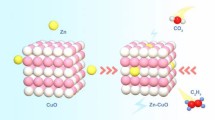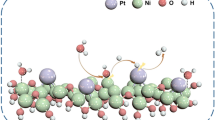Abstract
Precise manipulation of atomic defects is essential for modulating the intrinsic properties of two-dimensional (2D) materials. In this study, sulfur (S) atoms are accurately knocked out in the 2D basal plane of pure tin disulfide (SnS2). By varying the annealing temperatures (250–350°C), SnS2 with different S vacancy concentrations (Vs−SnS2) can be obtained. When SnS2 is annealed at 350°C for 5 h, the S vacancies in the forms of single S atom and double S atoms could reach up to 30.5%. The Vs−SnS2 is tested in the microelectrocatalytic hydrogen evolution reaction (HER). Vs−SnS2 with S vacancies of 30.5% generates superior catalytic performance, with a Tafel slope of 74 mV dec−1 and onset potential of 141 mV. The mechanism has been proposed. First, computation confirms that the absence of S atoms prompts surface charge modulation and enhances electronic conductivity. In addition, the under-coordinated Sn atoms adjacent to S vacancy introduce the lattice distortion and charge density redistribution, which are beneficial to hydrogen binding in HER. In short, accurate knockout of specific atoms by controlling the annealing temperature is a promising strategy to explore structure-dependent properties of various 2D materials.

摘要
精确调控二维平面内的原子缺陷可有效调节二维材料的各种基本性质. 本研究通过改变退火温度(250–350°C), 实现了二维二硫化锡(SnS2)基面上硫(S)原子的精确敲除, 得到了具有不同S空位浓度的SnS2(Vs−SnS2). 当SnS2 在350°C下退火5 h时, 大量出现单S原子和双S原子空位形态, S空位浓度可达30.5%. 在自制微芯片中测试Vs−SnS2的电催化析氢性能. S空位浓度达到30.5%的Vs−SnS2表现出优异的催化性能, Tafel斜率达到74 mV dec−1, 起始电位低至141 mV. 通过理论计算对反应机制进行研究, 结果表明, S原子的缺失促进了表面电荷调制, 提高了SnS2的导电性. 此外, S空位导致Sn原子的不饱和配位, 从而引起晶格畸变和电荷密度重新分布, 更加有利于析氢反应. 简而言之, 通过控制退火温度可精确敲除特定原子、制造缺陷, 可成为探索各种2D材料结构相关特性的一种有效策略.
Similar content being viewed by others
References
Shao G, Lu Y, Hong J, et al. Seamlessly splicing metallic SnxMo1−xS2 at MoS2 edge for enhanced photoelectrocatalytic performance in microreactor. Adv Sci, 2020, 7: 2002172
Schulman DS, Arnold AJ, Das S. Contact engineering for 2D materials and devices. Chem Soc Rev, 2018, 47: 3037–3058
Xu Y, Jiang X, Shao G, et al. Interface effect of Ru−MoS2 nanoflowers on lignin substrate for enhanced hydrogen evolution activity. Energy Environ Mater, 2021, 4: 117–125
Alzakia FI, Tan SC. Liquid-exfoliated 2D materials for optoelectronic applications. Adv Sci, 2021, 8: 2003864
Guo HW, Hu Z, Liu ZB, et al. Stacking of 2D materials. Adv Funct Mater, 2021, 31: 2007810
Su L, Fan X, Yin T, et al. Inorganic 2D luminescent materials: Structure, luminescence modulation, and applications. Adv Opt Mater, 2020, 8: 1900978
Wang X, Zhang Y, Si H, et al. Single-atom vacancy defect to trigger high-efficiency hydrogen evolution of MoS2. J Am Chem Soc, 2020, 142: 4298–4308
Xiong J, Di J, Xia J, et al. Surface defect engineering in 2D nanomaterials for photocatalysis. Adv Funct Mater, 2018, 28: 1801983
Loh L, Zhang Z, Bosman M, et al. Substitutional doping in 2D transition metal dichalcogenides. Nano Res, 2021, 14: 1668–1681
Li W, Qian X, Li J. Phase transitions in 2D materials. Nat Rev Mater, 2021, 6: 829–846
Xu X, Pan Y, Liu S, et al. Seeded 2D epitaxy of large-area single-crystal films of the van der Waals semiconductor 2H MoTe2. Science, 2021, 372: 195–200
Stark MS, Kuntz KL, Martens SJ, et al. Intercalation of layered materials from bulk to 2D. Adv Mater, 2019, 31: 1808213
Shao G, Xue XX, Zhou X, et al. Shape-engineered synthesis of atomically thin 1T-SnS2 catalyzed by potassium halides. ACS Nano, 2019, 13: 8265–8274
Zhang L, Tang Y, Khan AR, et al. 2D materials and heterostructures at extreme pressure. Adv Sci, 2020, 7: 2002697
Wang X, Pan L, Yang J, et al. Direct synthesis and enhanced rectification of alloy-to-alloy 2D type-II MoS2(1−x)Se2x/SnS2(1−y)Se2y heterostructures. Adv Mater, 2021, 33: 2006908
Xu X, Han B, Liu S, et al. Atomic-precision repair of a few-layer 2H-MoTe2 thin film by phase transition and recrystallization induced by a heterophase interface. Adv Mater, 2020, 32: 2000236
Hu D, Zhao T, Ping X, et al. Unveiling the layer-dependent catalytic activity of PtSe2 atomic crystals for the hydrogen evolution reaction. Angew Chem Int Ed, 2019, 58: 6977–6981
Cui F, Wang C, Li X, et al. Tellurium-assisted epitaxial growth of large-area, highly crystalline ReS2 atomic layers on mica substrate. Adv Mater, 2016, 28: 5019–5024
Shi R, Zhao Y, Waterhouse GIN, et al. Defect engineering in photocatalytic nitrogen fixation. ACS Catal, 2019, 9: 9739–9750
Xie J, Yang X, Xie Y. Defect engineering in two-dimensional electrocatalysts for hydrogen evolution. Nanoscale, 2020, 12: 4283–4294
Shao G, Xue Xx, Wu B, et al. Template-assisted synthesis of metallic 1T′-Sn0.3W0.7S2 nanosheets for hydrogen evolution reaction. Adv Funct Mater, 2020, 30: 1906069
Zheng YJ, Chen Y, Huang YL, et al. Point defects and localized excitons in 2D WSe2. ACS Nano, 2019, 13: 6050–6059
Liang Q, Zhang Q, Gou J, et al. Performance improvement by ozone treatment of 2D PdSe2. ACS Nano, 2020, 14: 5668–5677
Zhang P, Xiang H, Tao L, et al. Chemically activated MoS2 for efficient hydrogen production. Nano Energy, 2019, 57: 535–541
Xu J, Lai S, Hu M, et al. Semimetal 1H-SnS2 enables high-efficiency electroreduction of CO2 to CO. Small Methods, 2020, 4: 2000567
Wang P, Song S, Najafi A, et al. High-fidelity transfer of chemical vapor deposition grown 2D transition metal dichalcogenides via substrate decoupling and polymer/small molecule composite. ACS Nano, 2020, 14: 7370–7379
Wakafuji Y, Moriya R, Masubuchi S, et al. 3D manipulation of 2D materials using microdome polymer. Nano Lett, 2020, 20: 2486–2492
Kim K, Yankowitz M, Fallahazad B, et al. Van der Waals heterostructures with high accuracy rotational alignment. Nano Lett, 2016, 16: 1989–1995
Wang W, Zhou L, Hu S, et al. Visualizing piezoelectricity on 2D crystals nanobubbles. Adv Funct Mater, 2021, 31: 2005053
Shao G, Xue XX, Liu X, et al. Twist angle-dependent optical responses in controllably grown WS2 vertical homojunctions. Chem Mater, 2020, 32: 9721–9729
Ye G, Gong Y, Lei S, et al. Synthesis of large-scale atomic-layer SnS2 through chemical vapor deposition. Nano Res, 2017, 10: 2386–2394
Zhang X, Liao Q, Kang Z, et al. Hidden vacancy benefit in monolayer 2D semiconductors. Adv Mater, 2021, 33: 2007051
Bai F, Xu L, Zhai X, et al. Vacancy in ultrathin 2D nanomaterials toward sustainable energy application. Adv Energy Mater, 2020, 10: 1902107
Gong Y, Yuan H, Wu CL, et al. Spatially controlled doping of two-dimensional SnS2 through intercalation for electronics. Nat Nanotech, 2018, 13: 294–299
Jin H, Li L, Liu X, et al. Nitrogen vacancies on 2D layered W2N3: A stable and efficient active site for nitrogen reduction reaction. Adv Mater, 2019, 31: 1902709
Wang Z, Li Q, Xu H, et al. Controllable etching of MoS2 basal planes for enhanced hydrogen evolution through the formation of active edge sites. Nano Energy, 2018, 49: 634–643
Deng D, Novoselov KS, Fu Q, et al. Catalysis with two-dimensional materials and their heterostructures. Nat Nanotech, 2016, 11: 218–230
Ge J, Zheng JY, Zhang J, et al. Controllable atomic defect engineering in layered NixFe1−x(OH)2 nanosheets for electrochemical overall water splitting. J Mater Chem A, 2021, 9: 14432–14443
Greeley J, Jaramillo TF, Bonde J, et al. Computational high-throughput screening of electrocatalytic materials for hydrogen evolution. Nat Mater, 2006, 5: 909–913
Acknowledgements
This work was supported by the National Natural Science Foundation of China (22175060 and 21975067) and the Natural Science Foundation of Hunan Province, China (2021JJ10014 and 2021JJ30092). Feng Y acknowledges the support from the National Natural Science Foundation of China (11974105), the National Basic Research Program of China (2016YFA0300901). Xu J acknowledges the support from the Natural Science Foundation of Jiangsu Province, China (BK20210729), and the Collaborative Innovation Center of Suzhou Nano Science and Technology, the 111 Project and the Joint International Research Laboratory of Carbon-Based Functional Materials and Devices. The computational resources were provided by the supercomputer TianHe in Changsha, China.
Author information
Authors and Affiliations
Contributions
Author contributions Shao G and Xu J conceived the research. Shao G designed the experiments. Shao G and Xiang H performed the experiments and data analysis. Xue XX and Huang M contributed to the DFT simulation. Xu J, Zong Y, and Luo J performed STEM characterizations. Shao G, Xue XX, Feng Y, Zhou Z, Xu J and Liu S contributed to manuscript editing. Shao G, Liu S and Xue XX wrote the manuscript. All authors contributed to the general discussion.
Corresponding authors
Ethics declarations
Conflict of interest The authors declare that they have no conflict of interest.
Additional information
Gonglei Shao received his PhD degree in chemistry from Hunan University in 2021. He joined the School of Chemical Engineering, Zhengzhou University as a researcher. At present, he is mainly engaged in the design and properties of novel 2D transition metal sulfide catalysts, the preparation of large-area 2D materials by chemical vapor deposition, and the preparation of ternary or multivariate 2D alloy materials.
Xiong-Xiong Xue received his PhD degree in physics from Hunan University in 2020. He is currently an associate professor at the School of Physics and Optoelectronics, Xiangtan University. His research concerns novel physical properties and applications of low-dimensional materials.
Jie Xu received his PhD degree from the School of Materials Science and Engineering, Tianjin University of Technology in 2020. Now he is a lecturer at the Institute of Functional Nano and Soft Materials (FUNSOM), Soochow University, China. His current interests include two-dimensional materials and electron microscopy research.
Song Liu received his PhD degree in 2011 from Peking University. He was a postdoctoral fellow working in Prof. Liming Dai’s group (2011–2013) in Case Western Reserve University. After three years research at the National University of Singapore (2013–2016), he is now a full professor at the Institute of Chemical Biology and Nanomedicine, Hunan University. His research interests focus on the controlled synthesis of low-dimensional materials, the application research of functional devices and Nano biological research.
Supplementary information Supporting data are available in the online version of the paper.
Supporting Information
Rights and permissions
About this article
Cite this article
Shao, G., Xiang, H., Huang, M. et al. S vacancies in 2D SnS2 accelerating hydrogen evolution reaction. Sci. China Mater. 65, 1833–1841 (2022). https://doi.org/10.1007/s40843-021-1991-6
Received:
Accepted:
Published:
Issue Date:
DOI: https://doi.org/10.1007/s40843-021-1991-6




